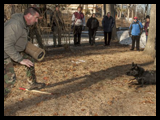
Officers and working dogs from local police K-9 units recently came to the U.S. Army Research Institute of Environmental Medicine to meet with scientists from USARIEM and MIT Lincoln Laboratories, who are involved with the program to evaluate thermal.
|
NATICK, Mass. (Jan. 31, 2014) ---
Last summer, Ken Ballinger, a K-9 officer with the Plymouth County Sheriff's Department, was conducting a training session with working dogs on a hot and humid New England day.
For safety, Ballinger had arranged for two veterinarians and three paramedics to be on site. When the dogs were not working, they were resting in air-conditioned vehicles, and checked on every 15 minutes. On one of these routine checks, Ballinger's dog, Blitz, a 3-year-old Shepherd, did not respond.
The vehicle had failed, so that instead of blowing cool air, 200-degree engine air flowed into the cabin where Blitz was. Blitz was unconscious when he was pulled from the vehicle. Emergency treatment began immediately, including application of ice packs, administration of intravenous fluids and rapid transport to Angell Animal Medical Center, located only five minutes away.
An hour later, Blitz's core temperature was still 109 degrees, far above normal; yet within two weeks he was back to work. In the veterinary community, this was the highest temperature documented with survival.
"Heat stress is a significant concern for military working dogs, or MWDs, both during training and deployment," said Kate O'Brien, a research physiologist at the U.S. Army Research Institute of Environmental Medicine, or USARIEM, in Natick, Mass. "If heat illness occurs, even if it is not fatal, MWDs are often retired from service, resulting in loss of a valuable resource that is costly with respect to both time and money."
USARIEM's Biophysics and Biomedical Modeling Division is working with the Massachusetts Institute of Technology's Lincoln Laboratory to solve this problem through a program to examine thermal stress in military working dogs.
"Real-time physiological monitoring can be used in humans to identify individuals who are at risk of excessive heat strain," said O'Brien.
For example, O'Brien said, Weapons of Mass Destruction Civil Support Teams have used handheld "buddy" displays to see when an individual is becoming too hot and could use that information for better mission management.
"A similar approach could be used with MWDs to send information to the handler when the dog is overheating," O'Brien said. "The handler could then take action to both avoid performance degradation and reduce risk of heat illness."
O'Brien said that while heat illness occurs less often in civil working dog populations, sometimes things happen despite best efforts to prevent it.
A few months later, Blitz had an implanted temperature sensor in his chest. Data is transmitted so that handlers can monitor Blitz's temperature in real-time, as well as be alerted if he reaches a critical preset threshold temperature.
"It may not be feasible to surgically implant every MWD with a temperature sensor," O'Brien said. "However, USARIEM has demonstrated in humans that heat tolerance can be tracked in real-time using data obtained from non-invasive physiological measurements in combination with algorithms and models that predict core temperature."
This capability for monitoring humans was developed through USARIEM's expertise in thermal physiology, biophysics and mathematical modeling. Expertise from MIT Lincoln Laboratory in signal processing, data storage and microprocessing contributed to the methodology for transmitting this information to the individual. Together, USARIEM and MIT Lincoln Labs are currently working on a very low power, size and weight physiological status monitoring system for humans. This same approach is being applied to monitoring heat strain in MWDs.
"Through partnerships with the MWD community, local police K-9 units, and MIT Lincoln Labs, USARIEM will be developing products and strategies to reduce heat injuries and sustain performance in working dogs for military and law enforcement," O'Brien said.
Learn more at Army.mil
|